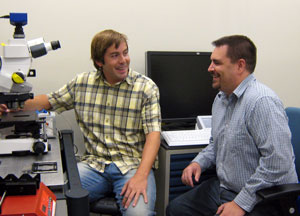Recent News
UNM Engineering Ph.D. candidate named ASCE ‘24 Outstanding Reviewer
August 11, 2025
UNM joins Brown University in national institute focused on intuitive, trustworthy AI assistants
August 6, 2025
UNM Engineering team wins ASEE best paper for work on first-year engineering course
July 17, 2025
New director will enhance interdisciplinary engineering learning opportunities
July 2, 2025
News Archives
The Friday Afternoon Breakthrough
November 15, 2012
 11-15-12 – “Friday afternoon is usually the best time to do science. There’s somehow less pressure. The week is behind you. You may get to sleep in tomorrow morning, so why not just try something?” said Bryon Kaehr, a research assistant professor in the UNM Department of Chemical and Nuclear Engineering. The results of this Friday afternoon experiment still make him smile. “Wow, that’s cool, where do I go from here?” he said.
11-15-12 – “Friday afternoon is usually the best time to do science. There’s somehow less pressure. The week is behind you. You may get to sleep in tomorrow morning, so why not just try something?” said Bryon Kaehr, a research assistant professor in the UNM Department of Chemical and Nuclear Engineering. The results of this Friday afternoon experiment still make him smile. “Wow, that’s cool, where do I go from here?” he said.
Bryan Kaehr (l.) and Jason Townson
His simple experiment may have far reaching impact for nanomaterials, for drug development, and for the whole field of bio-catalysis. Borrowing some cells from a Jason L. Townson, a cancer biologist from the Center for Micro-Engineered Materials who was working down the hall, Kaehr placed them in a chemical solution of silicon dioxide (the basic ingredient of glass) which allowed the cells to absorb the material. Then he baked them at 600 degrees for three hours.
The baking destroyed the biological material. He was left with a perfect inorganic replica of a cell. The structure was completely intact. When he sliced into the material, he could see the interior components as they were in the original cell. He had something he had never seen or read about. A perfect replica of a cell, but it wasn’t biological any more. It was a building material, something a materials scientist could actually use.
Technical details about the research are available in this just released paper published in the Proceedings of the National Academy of Sciences.
Kaehr worked with Townson, Robin M. Kalinich from the Sandia National Laboratories’ Advanced Materials Laboratory, Yasmine H. Awad and Darren R. Dunphy from the Department of Chemical and Nuclear Engineering at UNM, B.S. Swartzentruben from the Center for Integrated Nantotechnologies at UNM, and C. Jeffrey Brinker to prove the Friday afternoon experiment was everything he initially thought it was.
Currently researchers who work with nanomaterials have limitations. They can build wires and they can build spheres. They can’t make elaborate structures. But cells can be made to grow in complex ways. Add a little salt to solution in which a red blood cell is growing and it begins to sprout something that looks like fins. The combination of cells and chemistry present endless possibilities.
Glass replicas of red blood cell exposed to salt solution
Courtesy Bryan Kaehr
There is something else about this experiment. Despite the complete coverage of the cell in silica, the cell retains some enzyme function. Enzymes are the workhorses of biology. They do the heavy lifting in complex chemical processes such as photosynthesis in plants. If this process can be used to stabilize enzymes in a powder form, so they can be stored on a shelf, and then put in a solution and used when needed, the research group has found something really valuable.
Not valuable in terms of money. The process is so simple researchers with basic equipment can replicate it nearly anytime and anywhere. Valuable in terms of allowing lots of scientists work with materials in a way they never have before.
These materials can be carbonized, providing another interesting property. They are electrically conductive. That adds an interesting dimension to an experiment that is already interesting in other different ways.
Kaehr thinks he can use the process to build complex nanostructures. Other researchers may use the process to delve into bio-catalysis research because it stabilizes the enzymes so they might be used in harsh solvents or at high temperatures. The process may also offer a new way to manufacture high value pharmaceuticals.
Kaehr is an advanced materials researcher at Sandia National Laboratories, a research scientist at the University of New Mexico, and not long out of graduate school at the University of Texas-Austin. He grew up in Albuquerque, graduated from UNM and was a little surprised when a research fellowship brought him back to his hometown where he works out of the Sandia National Laboratories Advanced Materials Laboratory on the UNM campus. He is looking for grant funding now to take the research further.
It was a combination of the right time, the right lab, the right cancer biologist down the hall and a Friday afternoon, that gave Kaehr the last word, “We did some interesting science. I can’t wait to see what happens next.”
Media contact: Karen Wentworth (505) 277-5627; kwent2@unm.edu
